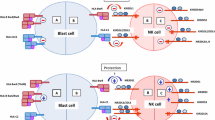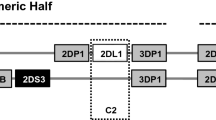Abstract
Many studies have described the role of killer immunoglobulin-like receptors (KIRs) and their cognate human leukocyte antigen (HLA) class I ligands in the immune protection against melanoma, but the effect of these markers on intra-individual variations in tumor development and progression has remained less clear. We performed KIR, HLA, and KIR/ligand analysis in 283 patients with malignant melanoma in order to evaluate their integrated influence on disease stage and progression. The patients were grouped according to AJCC staging, histological type of the primary tumor, progression, and survival rate. Analysis of HLA class I alleles revealed positive association of HLA-C*14 (Pc = 0.026, OR = 5.99) and negative association of HLA-C*02 (Pc = 0.026, OR = 0.43) with the disease. Decreased frequency of KIR2DS5 was observed in patients with rapid progression, as compared to those with slow progression. KIR BB genotype was prevalent in patients with metastasis (p = 0.004, OR = 0.025). KIR AA genotype was nearly twice as frequent in rapidly progressive cases, but without statistical relevance (p = 0.055, OR = 2.6). Significantly increased frequency of KIR2DL2 in the presence of C1 ligand (strong inhibition) was found in patients with AJCC III and IV, as compared to individuals with AJCC I stage (p = 0.045, OR = 1.93). In summary, our data imply that KIR/ligand gene content in patients could modulate the disease course towards unfavorable tumor behavior.
Similar content being viewed by others
References
Ali TH, Pisanti S, Ciaglia E et al (2014) Enrichment of CD56(dim)KIR + CD57 + highly cytotoxic NK cells in tumour-infiltrated lymph nodes of melanoma patients. Nat Commun 5:5639
Bashirova AA, Martin MP, McVicar DW et al (2006) The killer immunoglobulinlike receptor gene cluster: tuning the genome for defense. Annu Rev Genomics Hum Genet 7:277–300
Becker S, Tonn T, Fussel T et al (2003) Assessment of killer cell immunoglobulinlike receptor expression and corresponding HLA class I phenotypes demonstrates heterogenous kir expression independent of anticipated HLA class I ligands. Hum Immunol 64:183–193
Bettinotti MP, Norris RD, Hackett JA et al (2000) Frequency of human leukocyte antigen-A 24 alleles in patients with melanoma determined by human leukocyte antigen-A sequence-based typing. J Immunother 23:282–287
Bonamigo RR, Carvalho AV, Sebastiani VR et al (2012) HLA and skin cancer. An Bras Dermatol 87:9–18
Boyington JC, Sun PD (2002) A structural perspective on MHC class I recognition by killer cell immunoglobulin-like receptors. Mol Immunol 38:1007–1021
Boyton RJ, Altmann DM (2007) Natural killer cells, killer immunoglobulin-like receptors and human leucocyte antigen class I in disease. Clin Exp Immunol 149:1–8
Campillo JA, Legaz I, López-Álvarez MR et al (2013) KIR gene variability in cutaneous malignant melanoma: influence of KIR2D/HLA-C pairings on disease susceptibility and prognosis. Immunogenetics 65:333–343
Carlsten M, Malmberg KJ, Ljunggren HG (2009) Natural killer cell-mediated lysis of freshly isolated human tumor cells. Int J Cancer 124:757–762
Chen S, Kawashima H, Lowe JB et al (2005) Suppression of tumor formation in lymph nodes by l-selectin-mediated natural killer cell recruitment. J Exp Med 202:1679–1689
Della Chiesa M, Romeo E, Falco M et al (2008) Evidence that the KIR2DS5 gene codes for a surface receptor triggering natural killer cell function. Eur J Immunol 38:2284–2289
Garrido F, Cabrera T, Aptsiauri N (2010) “Hard” and “soft” lesions underlying the HLA class I alterations in cancer cells: implications for immunotherapy. Int J Cancer 127:249–256
Gogas H, Kirkwood JM, Falk CS et al (2010) Correlation of molecular human leukocyte antigen typing and outcome in high-risk melanoma patients receiving adjuvant interferon. Cancer 116:4326–4333
Gonzalez-Galarza FF, Christmas S, Middleton D et al (2011) Allele frequency net: a database and online repository for immune gene frequencies in worldwide populations. Nucleic Acid Res 39:D913–D919
Gumperz JE, Barber LD, Valiante NM et al (1997) Conserved and variable residues within the Bw4 motif of HLA-B make separable contributions to recognition by the NKB1 killer cell-inhibitory receptor. J Immunol 158:5237–5241
Hansasuta P, Dong T, Thananchai H et al (2004) Recognition of HLA-A3 and HLA-A11 by KIR3DL2 is peptide-specific. Eur J Immunol 34:1673–1679
Khakoo SI, Carrington M (2006) KIR and disease: a model system or system of models? Immunol Rev 214:186–201
Kim S, Poursine-Laurent J, Truscott SM et al (2005) Licensing of natural killer cells by host major histocompatibility complex class I molecules. Nature 436:709–713
Ljunggren HG, Karre K (1990) In search of the ‘missing self’: MHC molecules and NK cell recognition. Immunol Today 11:237–244
Martin MP, Borecki IB, Zhang Z et al (2010) HLA-Cw group 1 ligands for KIR increase susceptibility to invasive cervical cancer. Immunogenetics 62:761–765
Messaoudene M, Fregni G, Fourmentraux-Neves E et al (2014) Mature cytotoxic CD56(bright)/CD16(+) natural killer cells can infiltrate lymph nodes adjacent to metastatic melanoma. Cancer Res 74:81–92
Metzelaar-Blok JA, Hurks HM, Naipal A et al (2005) Normal HLA class I, II, and MICA gene distribution in uveal melanoma. Mol Vis 11:1166–1172
Middleton D, Vilchez JR, Cabrera T et al (2007) Analysis of KIR gene frequencies in HLA class I characterised bladder, colorectal and laryngeal tumours. Tissue Antigens 69:220–226
Mihaylova A, Mihailova S, Naumova E (2008) NK Cell Receptor and MHC Gene Polymorphisms, Potential Relevance in Malignancies. Currt Cancer Ther Rev 4:130–136
Moretta A, Bottino C, Vitale M et al (1996) Receptors for HLA class-I molecules in human natural killer cells. Annu Rev Immunol 14:619–648
Naumova E, Mihaylova A, Stoitchkov K et al (2005) Genetic polymorphism of NK receptors and their ligands in melanoma patients: prevalence of inhibitory over activating signals. Cancer Immunol Immunother 54:172–178
Naumova E, Mihaylova A, Ivanova M et al (2007) Impact of KIR/HLA ligand combinations on immune responses in malignant melanoma. Cancer Immunol Immunother 56:95–100
Nelson GW, Martin MP, Gladman D et al (2004) Cutting edge: heterozygote advantage in autoimmune disease: hierarchy of protection/susceptibility conferred by HLA and killer Ig-like receptor combinations in psoriatic arthritis. J Immunol 173:4273–4276
Norman PJ, Stephens HA, Verity DH et al (2001) Distribution of natural killer cell immunoglobulin-like receptor sequences in three ethnic groups. Immunogenetics 52:195–205
Parham P (2005) MHC class I molecules and KIRs in human history, health and survival. Nat Rev Immunol 5:201–214
Rajagopalan S, Long EO (2005) Understanding how combinations of HLA and KIR genes influence disease. J Exp Med 201:1025–1029
Schadendorf D, Ugurel S, Schuler-Thurner B et al (2006) Dacarbazine (DTIC) versus vaccination with autologous peptide-pulsed dendritic cells (DC) in first-line treatment of patients with metastatic melanoma: a randomized phase III trial of the DC study group of the DeCOG. Ann Oncol 17:563–570
Schönberg K, Sribar M, Enczmann J et al (2011) Analyses of HLA-C-specific KIR repertoires in donors with group A and acquisition B haplotypes suggest a ligand-instructed model of NK cell receptor. Blood 117:98–107
Terasaki P, Gjertson D (1997) HLA. In: Ferencik S, Grosse-Wilde H UCLA Tissue Typing Laboratory (1st edn), pp 222–223
Toneva M, Lepage V, Lafay G et al (2001) Genomic diversity of natural killer cell receptor genes in three populations. Tissue Antigens 57:358–362
Uhrberg M, Valiante NM, Shum BP et al (1997) Human diversity in killer cell inhibitory receptor genes. Immunity 7:753–763
Acknowledgements
This work was supported by the European Union Sixth Framework Program. It was a part of the ENACT European project, 2SHC-CT-2004-503306.
Author information
Authors and Affiliations
Corresponding author
Ethics declarations
Conflict of interest
The authors declare that there is no conflict of interest with regard to the work presented in this article.
About this article
Cite this article
Kandilarova, S.M., Paschen, A., Mihaylova, A. et al. The Influence of HLA and KIR Genes on Malignant Melanoma Development and Progression. Arch. Immunol. Ther. Exp. 64 (Suppl 1), 73–81 (2016). https://doi.org/10.1007/s00005-016-0437-3
Received:
Accepted:
Published:
Issue Date:
DOI: https://doi.org/10.1007/s00005-016-0437-3




